IB VISUAL ARTS 2023
isabel smith
My exhibition centres on the idea of loss in the natural world. As a young person, I have grown up amid failing ecosystems, rapidly declining biodiversity and too many once-in-a-lifetime natural disasters to count. As such, the environmental crisis is deeply important to me and is something I feel very passionately about. In my artwork, I have explored the physical and psychological impacts of the climate crisis, created calls to action, and reflected upon sources of hope.
My initial inspiration came from news stories about climate change and environmental loss, and from the experience of having to live with and process these stories. In my exhibition, I was able to represent the problems these news stories addressed, such as bushfires, pollution and extinction, as well as explore the emotional effects of these phenomena - grief, worry and fear. Artists Patricia Piccinini, Juan Ford and Tim Storrier have also served as inspiration for conceptual ideas, subject matter and use of medium.
The artworks I have selected for this exhibition explore various aspects of the climate crisis, yet they remain connected by conceptual ideas, and by the symbol of smoke. Smoke, with its ephemeral, transient beauty and connotations of loss, waste and disappearance, is a recurring image in my artworks, and an oil painting of plumes of smoke sits at the centre of the exhibition. For me, smoke represents many of the ideas I am trying to address in my art: its delicate nature reflects our precarious ecosystems, and it is also a symbol of loss – a visual representation of something that no longer exists. Moreover, it itself is a pollutant. The idea that the natural world was going ‘up in smoke’ was a concept that I continually returned to.
Below this central oil painting sits the only three-dimensional artwork in the exhibition: a clay sculpture with its head in its hands. This sculpture represents my own grief and worry about environmental loss, so its central position is an indication that these emotions are what the rest of the exhibition has stemmed from. Despite representing me, the sculpture has been left ambiguous in terms of gender and race, so that other viewers may see themselves instead. In this way, the sculpture provides an entry point from which viewers can observe the rest of the exhibition.
Because the space in which I am presenting my exhibition is one long wall, I wanted most of my artworks to be two dimensional, hanging side by side. The artworks have been arranged so that the ideas and concepts within each individual piece evolve as the viewer moves out from the central sculpture. The inner-most paintings, closest to the sculpture, are explorations of the physical and psychological impacts of climate change: ‘Up in Smoke’, ‘Flora’, ‘Smoke Signals’ and ‘Dying Embers’ all focus on the tangible impacts of the environmental crisis. These artworks are created with oil paints, with the strength of the medium intended to reflect the intensity of the problems these artworks address, as well as ensure that these artworks are the focal point of the exhibition – the spot the viewer is immediately drawn to as they enter the space.
As the viewer moves out from this central focus, the medium becomes less intense. Having been introduced to the problems, the viewer is now faced with two watercolour paintings:
‘Memento Mori’ and ‘Going, going, gone’. These paintings act as calls to action, asking the viewer to reflect on their own role in the climate crisis, and on the ephemerality and brevity of the natural world.
Finally, the three charcoal drawings: ‘Fired Up’, ‘Looking Up’ and ‘Growing, growing, grown’. The last artworks the viewer sees, these are messages of optimism, examining potential resolutions to the climate crisis. Literally created with ash, these artworks draw hope from an issue that often seems hopeless.
Overall, my exhibition is a visual exploration of my feelings about the climate crisis – often despairing, sometimes hopeful, always in awe of the power and beauty of the natural world. I hope the viewer enjoys the aesthetic value of this exploration, whilst also reflecting on their own role in environmental loss, and the need for change.

Growing, growing, grown.
28 x 38cm
Charcoal drawing on paper
This artwork, which depicts the gradual growth of a tree sapling, is symbolic of hope and change. Though this exhibition is predominantly focused on images of destruction and loss, this artwork is one of optimism. I read about how after bushfires, plants often grow back stronger and healthier, and I felt that this could apply to the climate crisis. Though the state of our environment is often despairing, we have the ability to rebuild our relationship with the natural world, and to make this connection stronger.

Looking Up
57 x 41cm
Charcoal drawing on paper
‘Looking Up’ brings a note of optimism to the exhibition. The artwork depicts a photo I took of my younger sister looking up in awe and wonder at a Mountain Ash, Australia’s tallest tree. I loved the photo because, though her youth contrasts with the age and gravity of the tree, the connection between them is obvious. I think this connection and appreciation of the natural world is at the centre of resolving the climate crisis, and so this artwork is one of hopeful anticipation.
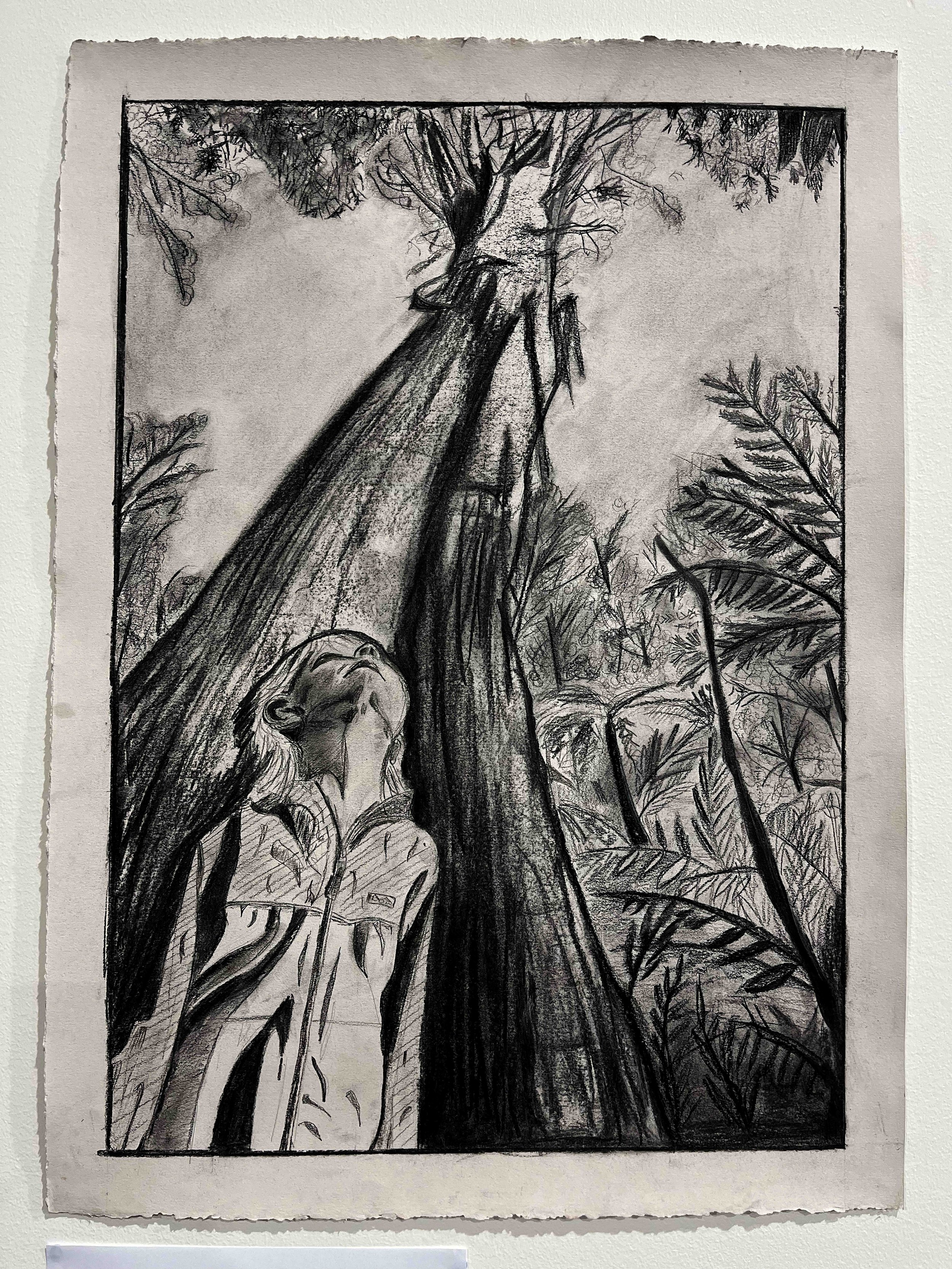
Going, going, gone.
28 x 80cm
Watercolour, fine liner on paper
This artwork examines the environmental loss and waste caused by human consumption. The triptych style shows the progression from something being shiny and new, to being used, to becoming waste. Matches are used to illustrate this process, as they symbolise both the ephemerality and brevity of the materials we consume, and tie into the central idea of our environment going ‘up in smoke’. My own hand is painted in the central artwork: an acknowledgement that I myself play a role in the consumption that is causing this ecological crisis.
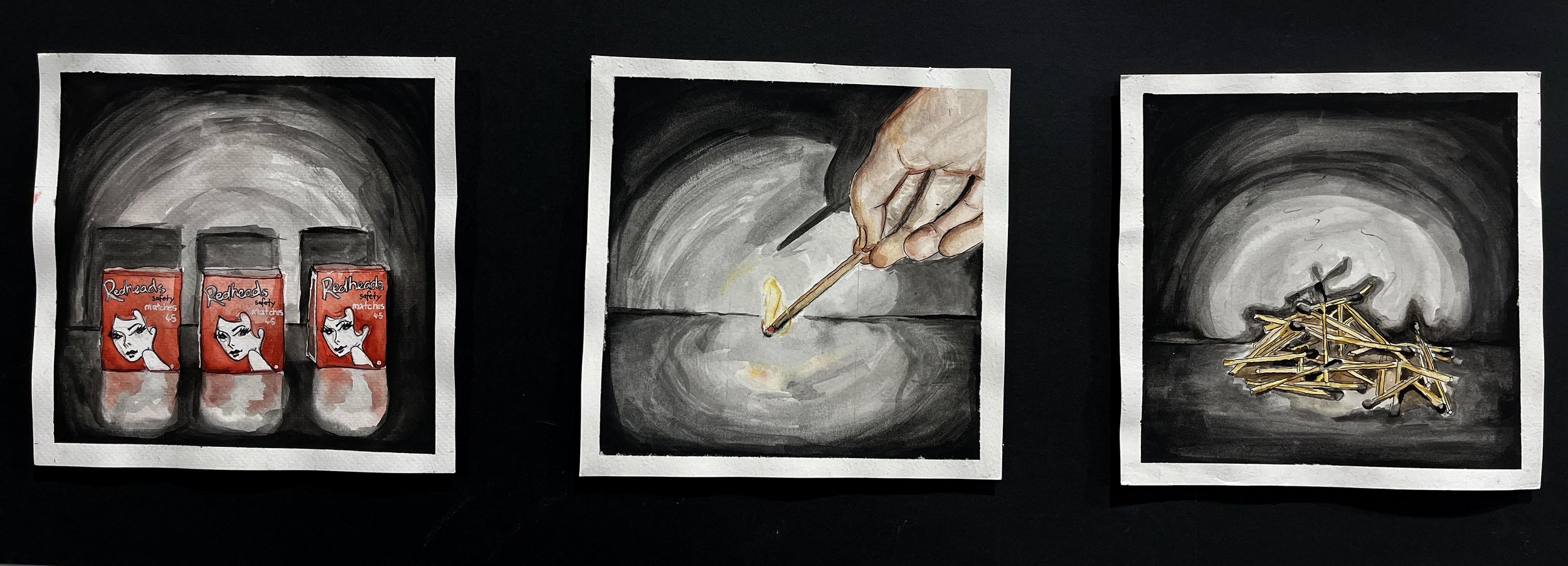
Flora
76 x 60cm
Oil paint on canvas
Made up of Australian plants and insects, ‘Flora’ is a portrait of the natural world personified – a representation of the inherent connection between humans and the earth. Yet the figure is singed at the edges, and smoke lingers eerily in the background. In this way, Flora is also an embodiment of the environmental loss that threatens this connection with nature. In giving Flora a human form, I hope the viewer can more easily connect to this loss and feel a sense of empathy.
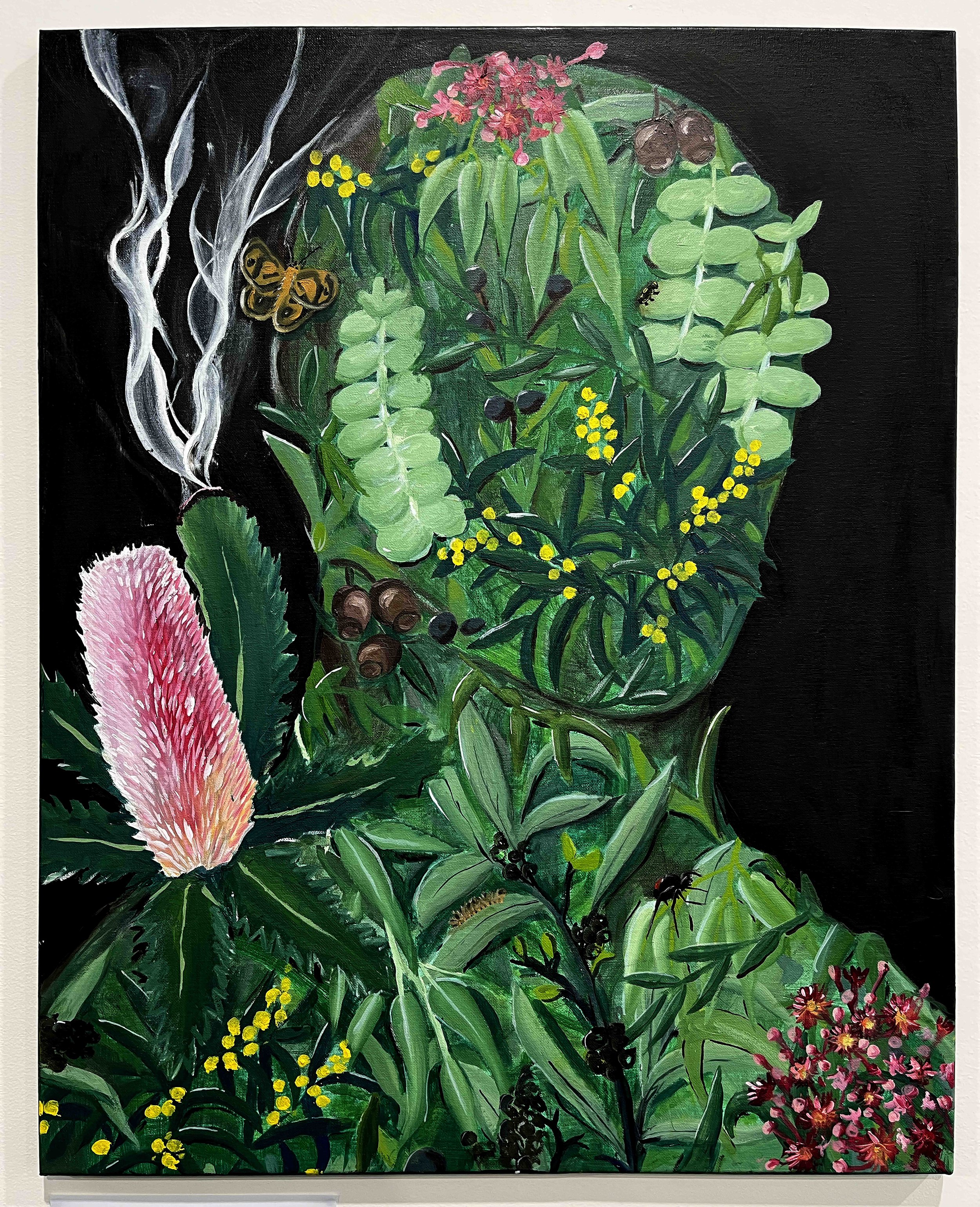
Up in Smoke
60 x 76cm
Oil paint on canvas
This artwork depicts plumes of smoke, which are a central motif in my exhibition. Smoke embodies many of the ideas associated with loss in the natural world; it is elusive and ephemeral, like our environment. Similarly, it is representative of loss and disappearance. It is also connected to ideas of waste, consumption, and pollution: all of which cause physical loss in the natural world. Smoke is a somewhat universal and eternal symbol, having been used in art for centuries, and the idea of the natural world going ‘up in smoke’ is central to this exhibition.
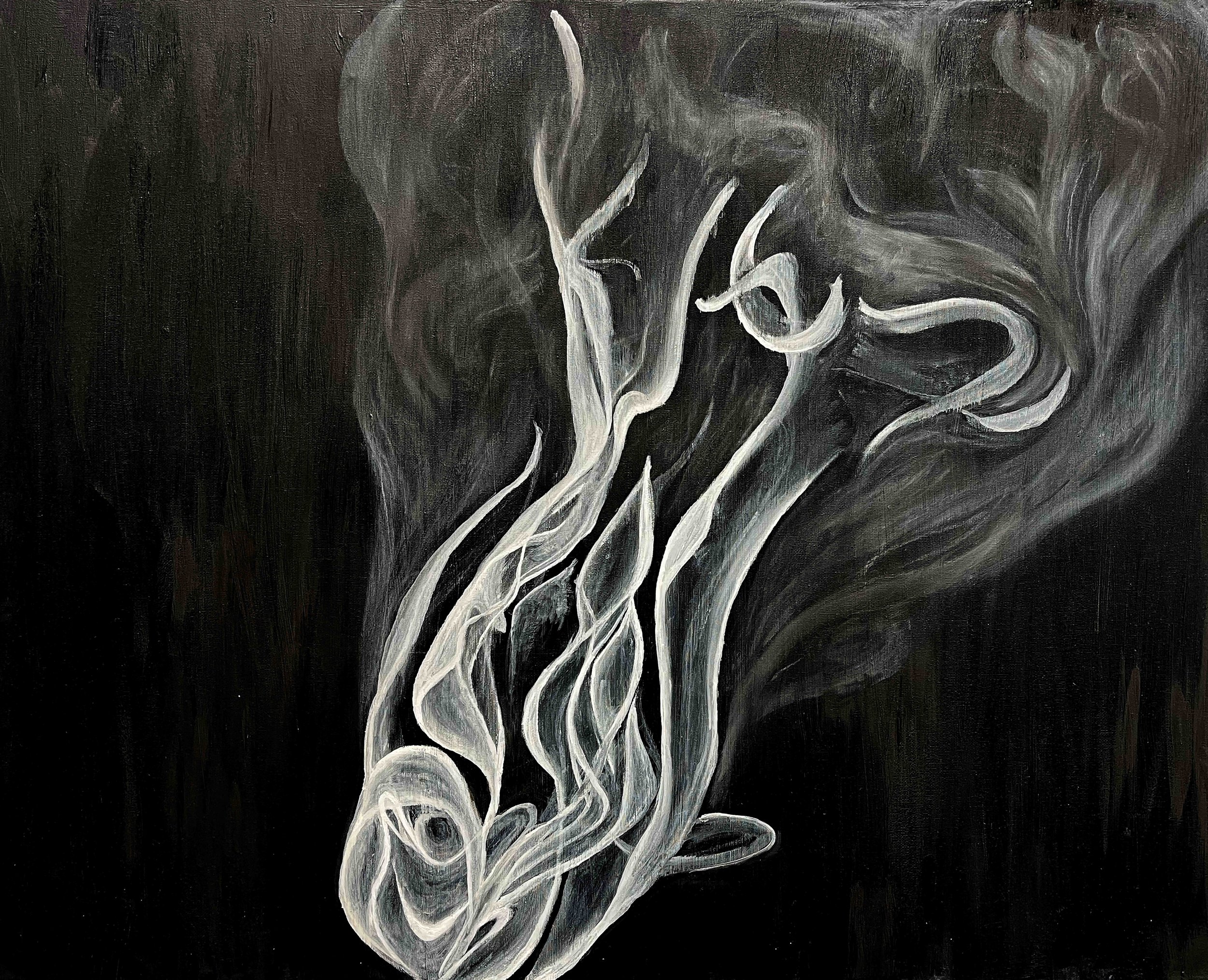
Grief
28 x 16 x 22cm
Clay, charcoal, eucalyptus leaves
This artwork is inspired by the psychological effects of climate change, particularly the growing phenomenon of ‘eco-anxiety’. For me, the overwhelming feeling associated with climate change is grief – an emotion I have tried to convey through this sculpture, which sits curled up and foetus-like, covered in burn-marks: an embodiment of sadness and distress. This sculpture, which is grieving for the natural beauty that surrounds it, sits at the centre of my exhibition, just as the sadness and loss it represents sit at the core of this body of art.

Dying Embers
45 x 40cm
Oil paint on canvas
In a recent study, the King Island Brown Thornbill was ranked first as the most likely Australian bird to go extinct, with the species on track to be eradicated within 20 years. This artwork acts as an homage to the bird, and to the hundreds of other Australian animals threatened by climate change. The recurring symbol of smoke sits in the background, and the thornbill is surrounded by a ghostly glow: haunting premonitions of things to come.
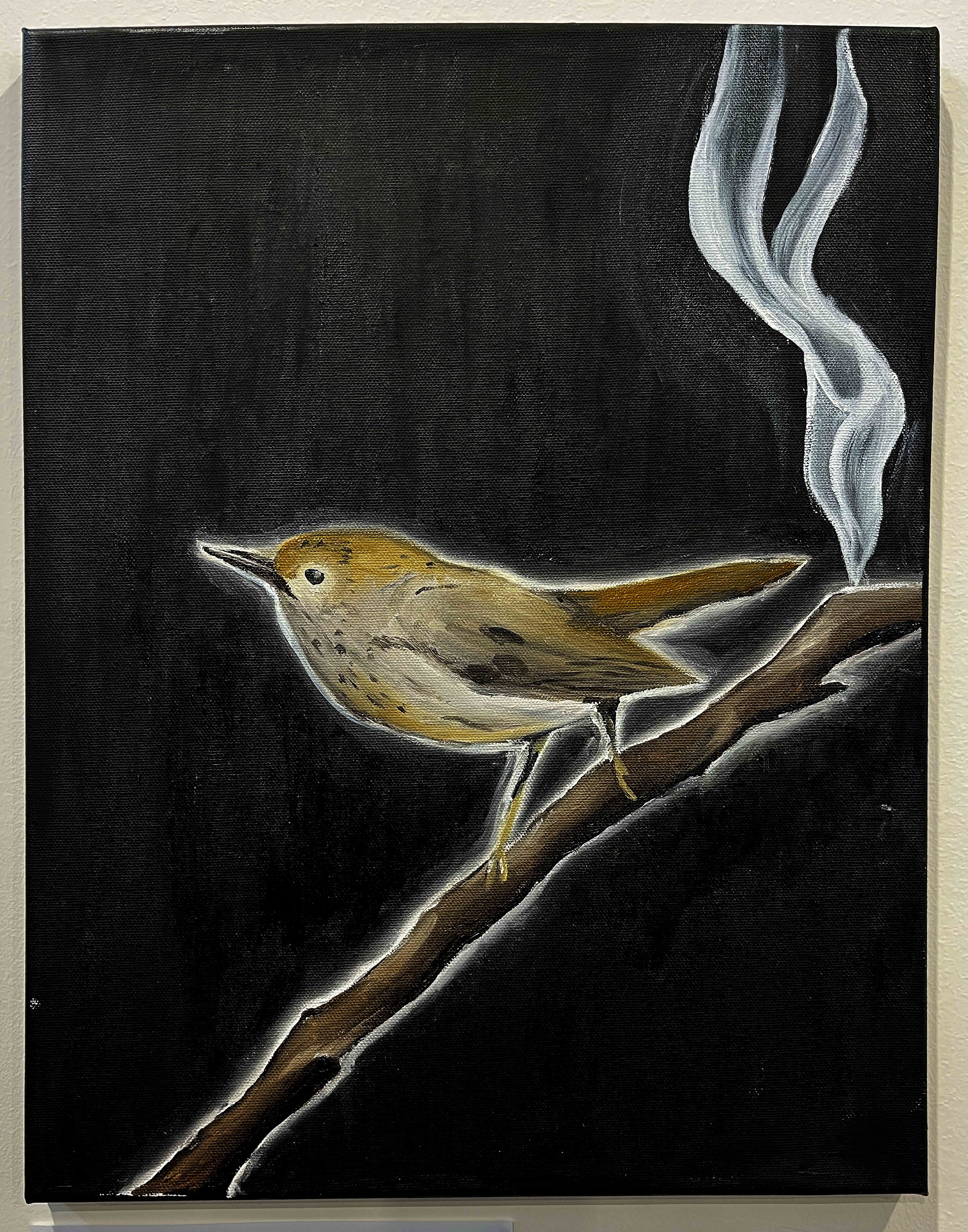
Memento Mori
41 x 58cm
Watercolour, fine liner on paper
This artwork explores environmental loss through the artistic principle of ‘Memento Mori’. This technique intends to remind the viewer of the brevity and delicacy of life, and of the worthlessness of material possessions. By interlacing classic symbols of Memento Mori and Vanitas (the waning candle, the clock, the bone, the rings) with images of leaves from my garden, I take this sentiment of remembering that time is finite and apply it how we feel about the natural world. This artwork aims to create reflection on the delicacy of our environment, in the hope that reflection elicits change.

Fired Up
36 x 57cm
Charcoal drawing on paper
This artwork is of a School Strike for Climate protest I attended in 2021. The artwork explores a source of hope for our environment: the growing pressure on governments and organisations to create systematic change. The signs held by protesters depict messages of defiance, anger and optimism. Together, they strive for a better future – one that isn’t threatened by climate change and environmental loss.

